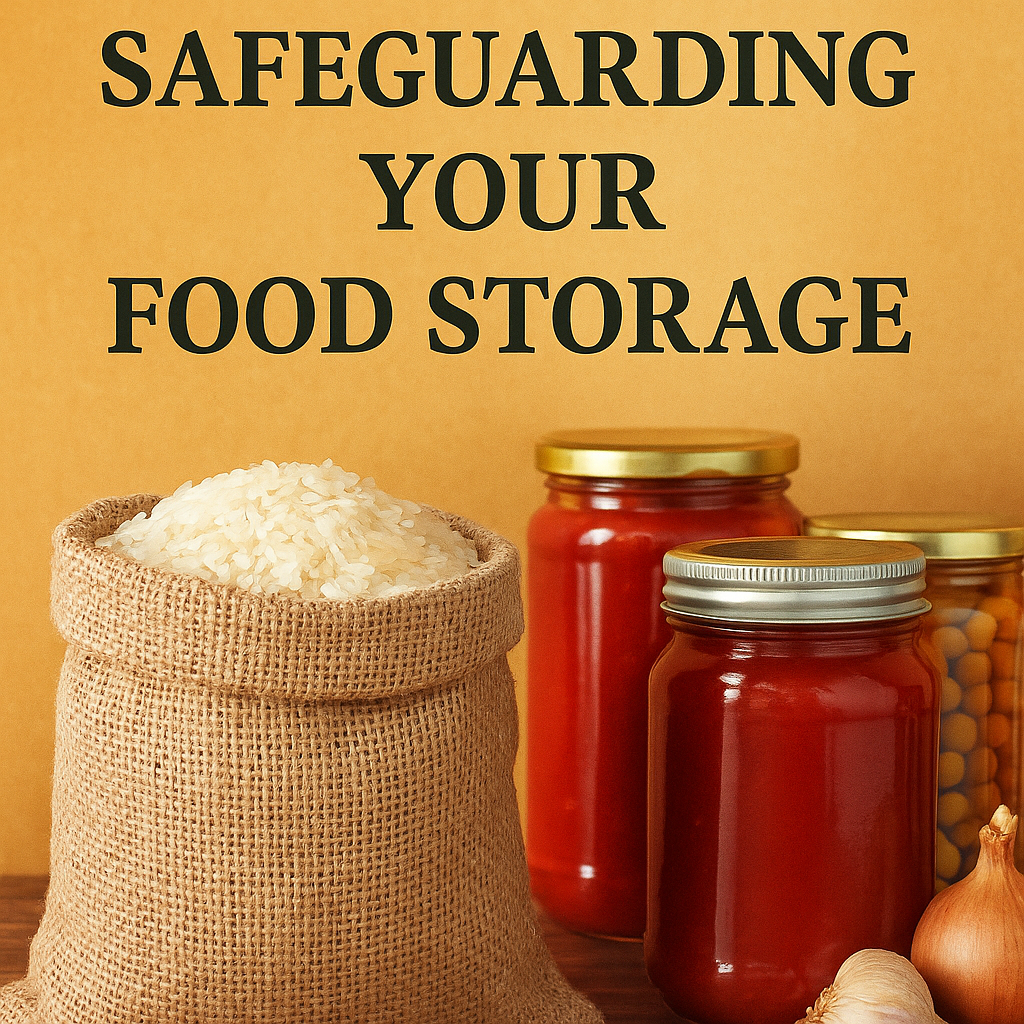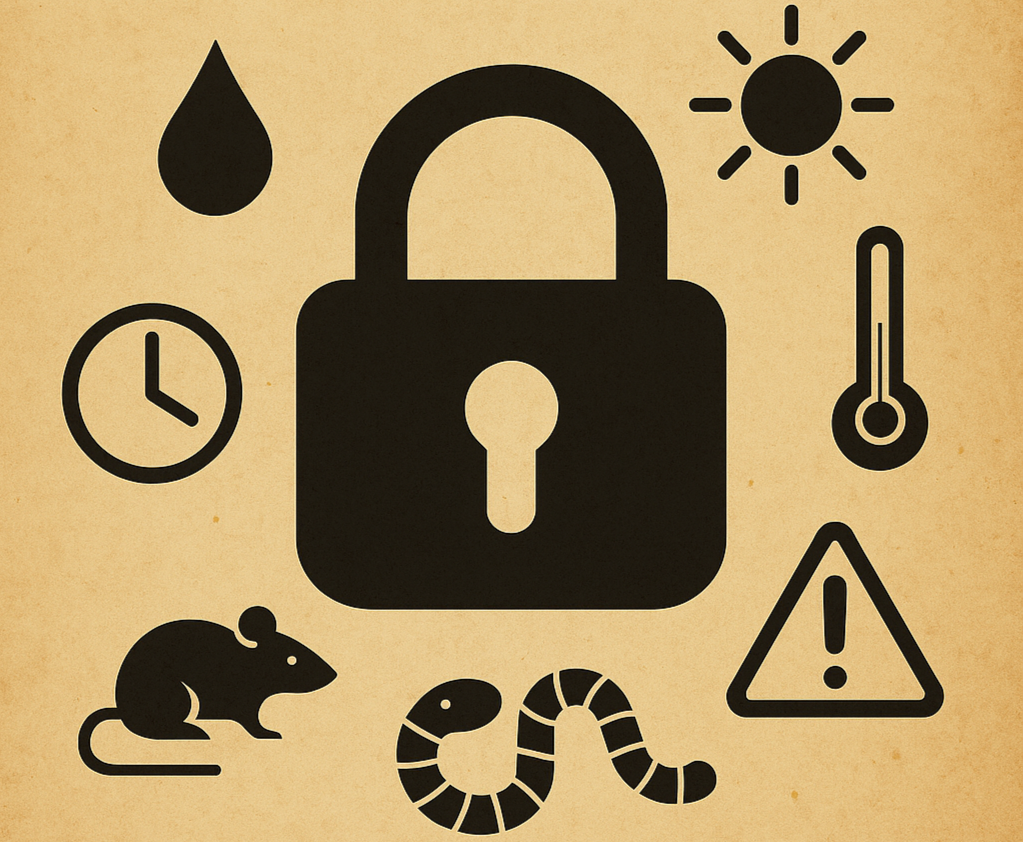Safeguarding Your Food Storage

In the world of food storage, your carefully preserved treasures can fall victim to a formidable lineup of adversaries. These seven foes, if left unchecked, can wreak havoc on your food supply, rendering it less nutritious, less flavorful, or even inedible. To maintain the quality and longevity of your stored food, it's crucial to understand and combat these enemies. In this article, we'll delve into the seven enemies of food storage and explore effective strategies to protect your culinary investments. Safeguarding Your Food Storage

1. Moisture
Moisture, including the humidity in the air, is a relentless adversary in the realm of food storage. Excessive moisture can encourage the growth of microorganisms and lead to mold formation. When your food is exposed to moisture, it becomes a breeding ground for harmful bacteria. To combat this foe: Safeguarding Your Food Storage
- Control Humidity: Maintain a humidity level of no more than 15 percent in your food storage area. Excess humidity can lead to rapid rehydration of your food, creating favorable conditions for bacterial growth.
- Use a Dehumidifier: Consider installing a dehumidifier or air conditioner in your storage space to regulate humidity. These devices can help ensure that moisture levels remain within acceptable limits.
- Package Rapidly: When removing food from a freeze-dryer, work quickly to package it, minimizing exposure to ambient humidity. Even with a dehumidifier in place, swift packaging is a key practice to protect your freeze-dried creations.
2. Light
Light is a stealthy enemy that can silently deteriorate the flavor, color, and nutritional value of your stored food. Some nutrients, especially fat-soluble vitamins like A, D, E, and K, are particularly susceptible to degradation when exposed to light. To shield your food from this threat:
- Avoid Direct Sunlight: Ensure that your food does not receive direct sunlight exposure. Direct sunlight can accelerate oxidation and lead to a loss of quality and nutritional value.
- Use Curtains or Shades: Install heavy curtains or shades on windows and skylights to block out sunlight. This simple measure can go a long way in preserving the quality of your stored food.
- Artificial Lighting: Rely on artificial lighting in your storage area, and remember to keep the room dark when not in use. This reduces the risk of light-induced food degradation.
- Mylar Bags and Amber Jars: Mylar bags offer excellent protection against light, effectively shielding your food from harmful rays. Additionally, amber canning jars can help block out light and protect the contents.
3. Temperature
Temperature plays a critical role in food storage, and excessive heat can be a relentless adversary. Heat above 70°F can lead to a loss of nutrition, flavor, texture, and appearance in stored food. To maintain the quality and shelf life of your food:
- Keep it Cool: Store your food in a cool place, ideally within the temperature range of 50°F to 70°F. Each 18°F increase above this range halves the shelf life of most stored foods.
- Respiratory Activities: Cooler temperatures reduce respiratory activities in stored food, preventing the development of excess moisture in the air. This helps maintain food quality over time.
- Prevent Ripening: Lower temperatures also slow down the ripening process in fruits and vegetables, which can lead to spoilage. Storing food in a hot location can cause it to rapidly degrade.
4. Oxygen
Oxygen is a silent saboteur that can alter the texture and flavor of foods while making fats turn rancid. Additionally, oxygen encourages the growth of microorganisms, leading to the proliferation of yeast and mold. To eliminate oxygen as a threat:
- Oxygen Absorbers: Use oxygen absorbers in your food storage containers. These absorbers remove oxygen from the environment, leaving behind nitrogen, an inert gas that protects your food.
- Strong Seals: Ensure your food storage containers have strong, airtight seals. These containers create a barrier against moisture, insects, and oxygen, preserving the quality of your food.
5. Pests
Pests, including rodents and insects, pose a significant threat to your food storage. These intruders can expose your food to the elements, spreading pathogens and causing contamination. To protect your food from pests:
- Rodent-Proof Containers: Use rodent-proof containers to store your food. These containers have tight seals that prevent pests from accessing your precious supplies.
- Mylar Bags Inside Containers: When using Mylar bags, place them inside rodent-proof containers like plastic buckets or totes. This additional layer of protection ensures that pests cannot damage the Mylar bags.
- Elevation: Store your food at least six inches off the floor. Elevating your food containers makes them less accessible to pests and reduces the risk of contamination from moisture, dust, and debris.
- Poison-Free Traps: Employ poison-free traps to keep rodents at bay. These traps provide an effective and humane way to deter pests from your food storage area. Safeguarding Your Food Storage
6. Time
Time is a relentless adversary that affects all stored foods, even those with long shelf lives. Over time, foods gradually lose their nutritional value, change in taste and appearance, and may eventually become unsafe to consume. To combat the relentless march of time:
- Rotate Your Food: Implement a food rotation system to ensure that you use the oldest items first. Regularly check your stored foods and prioritize the consumption of items approaching their expiration dates or showing signs of quality degradation.
- Shelf Life: While many freeze-dried items can last for decades when properly packaged, it's essential to monitor and rotate your food supply to maintain optimal quality.
7. Kids
While not a natural adversary of food storage, the curiosity of children can quickly deplete your carefully curated pantry. Children have a knack for finding and consuming their favorite treats, often with remarkable efficiency. To protect your food supply from curious young explorers:
- Separate Storage: If possible, keep your kitchen pantry food separate from the area where you store your long-term food supplies. This division can help prevent kids from accessing and depleting your food storage inadvertently.
- Clearly Defined Snacks: Make sure your children are aware of which items are allowable snacks, and safeguard the rest. Clearly communicate which foods are designated for everyday consumption and which are part of your long-term food storage.
- Get Kids Involved: Involve your children in building and maintaining your food storage. When they understand the importance of food preservation and preparation, they are more likely to respect and adhere to the guidelines.
By understanding and addressing the seven enemies of food storage, you can ensure that your culinary investments remain safe, nutritious, and flavorful. Whether you're preserving garden-fresh produce or freeze-dried delights, taking proactive steps to protect your food supply is essential. With proper storage practices in place, your food storage will stand strong against these relentless adversaries, ensuring that your culinary creations are ready to serve your family for years to come.
